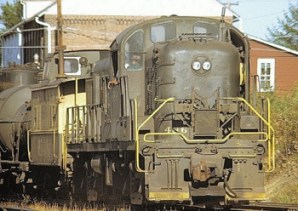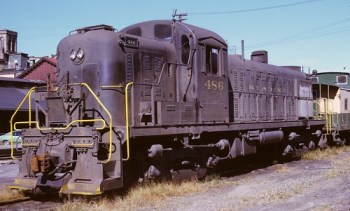Alco: RS-3
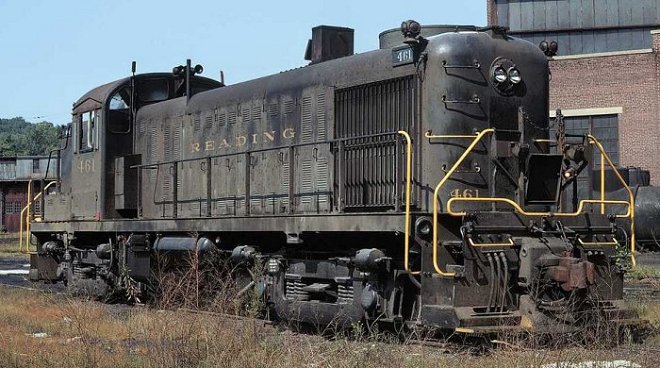
The Alco RS-3 road switcher locomotive was the first type of diesel road switcher locomotive acquired by the Reading. Assigned the Reading class RS-1 and numbering a total of 67 units, they were the most numerous class of locomotive on the railroad, and could be found performing a variety of duties all over the system. Many consider the RS-3s to be the "definitive" first-generation Reading diesel. The first group of Reading RS-3s were numbered 500-509 and were delivered in April, 1951, and entered freight service on the New York Branch between Bridgeport and points in New Jersey. In July of August of that year, locomotives #510-524 arrived and were used in the same territory.
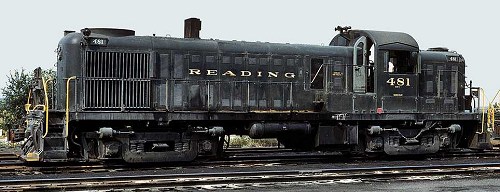
The initial success of this first group led the Reading to order additional in 1952. RS-3s #496-499 entered service during May, 1952, and were used on crossline freight between Rutherford and Allentown/Bethlehem, occasionally venturing west to Hagerstown, MD. At the same time, units #460-475 were delivered. These locomotives were intended for passenger service out of Philadelphia, and were equipped with steam generators. During the summer of 1952, locomotives #484-495 arrived at Rutherford, replacing N-1 Mallet and I-9 Consolidation steam locomotives operating there, accelerating the demise of steam on the Reading. The final ten units, #444-450 and #481-483, arrived in October and August 1953, respectively. These units replaced remaining I-9 and I-10 Consolidation steam locomotives.
|
|
|
The Reading's Alco RS-3s initially operated all over the Reading and Philadelphia Divisions, but did not venture north to the coal regions. The versatility of the "road switcher" type of locomotive, as opposed to a cab unit such as an EMD F-unit, was proven by the great variety of assignments for these locomotives in their early years:
Abrams: Yard drill, Philadelphia area branch jobs (Chester Valley, Plymouth), and mainline service to Bound Brook/Port Reading.
Bethlehem Branch: Local, mainline, and iron ore extra service.
Reading: Reading & Columbia / Wilmington & Northern through trains, Joanna Turn ore train, yard service.
Rutherford: Lebanon Valley & Gettysburg branch locals, crossline and mainline freight service.
Philadelphia: Run-through service on B&O trains to Jersey City.
Passenger service was most frequently the Main Line and North Penn trains to Reading, Pottsville and Bethlehem.
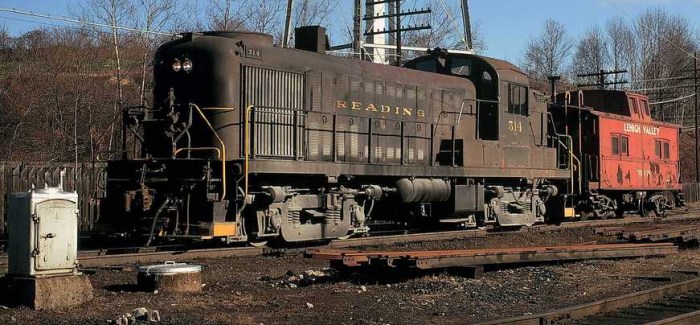
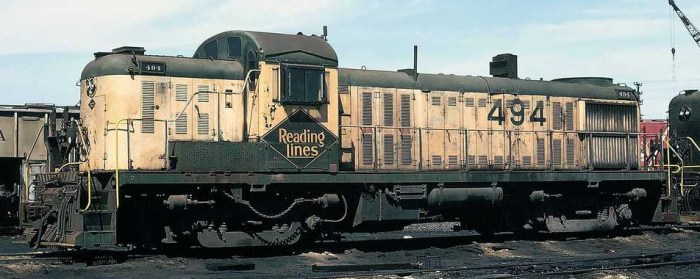
During their initial years of service on the Reading, the RS-3s only operated in matched sets, though from 1956 until the end of their careeers they could be seen MU'd with any other type of Reading locomotive. However, the Joanna Turn, Bethlehem Branch ore extras, and Bridgeport-Port Reading extras were only assigned "pure" sets of RS-3s. In later years, the RS-3s could also be seen on the Shamokin Division, working the various mine turns and branch jobs in the region.
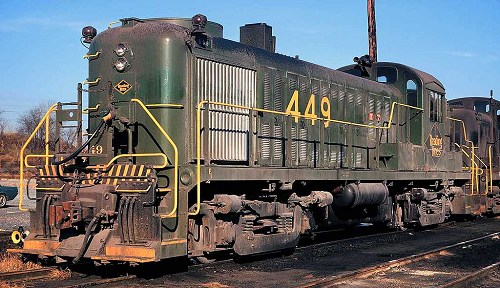 Three of the Reading's RS-3s, #445, 449 and 494, were repainted in the 1960s yellow-and-green paint scheme. Later on in 1972, #449 was painted in the "Reading Green" scheme, making it the only RS-3 (and only first generation road locomotive) to have worn all the Reading's paint schemes. #445 and #449 were often seen powering the Joanna Turn iron ore train on the Wilmington & Northern branch between the Grace Mine at Joanna and the Bethlehem Steel facilities in Bethlehem. The RS-3s were eventually replaced by GP40-2s on this job. Toward the end of their service, RS-3s were also used in yard service at various locations on the system. In addition, with the end of locomotive-hauled passenger trains, the passenger RS-3s were released to freight service as well. The RS-3s were incredibly versatile and performed a broad range of service during their time on the Reading, and roughly half the fleet went on to serve other owners after being retired by the railroad.
Three of the Reading's RS-3s, #445, 449 and 494, were repainted in the 1960s yellow-and-green paint scheme. Later on in 1972, #449 was painted in the "Reading Green" scheme, making it the only RS-3 (and only first generation road locomotive) to have worn all the Reading's paint schemes. #445 and #449 were often seen powering the Joanna Turn iron ore train on the Wilmington & Northern branch between the Grace Mine at Joanna and the Bethlehem Steel facilities in Bethlehem. The RS-3s were eventually replaced by GP40-2s on this job. Toward the end of their service, RS-3s were also used in yard service at various locations on the system. In addition, with the end of locomotive-hauled passenger trains, the passenger RS-3s were released to freight service as well. The RS-3s were incredibly versatile and performed a broad range of service during their time on the Reading, and roughly half the fleet went on to serve other owners after being retired by the railroad.
MODELING NOTES: Inclusion of several RS-3s would be appropriate for any Reading layout, as this was a very numerous class of locomotive that eventually operated all over the system. The preceding text describes operational patterns and assignments throughout their service, so bear that in mind when planning your operations. With regard to the locomotives themselves, there are a few details that will really make your RS-3s stand out. First, note the marker lights on the long hood. Also, take note of the location of the radio antennas and the air horns from the photos. Pay attention to the orientation of the stack as well - intially, the units were delivered with an air-cooled turbocharger, which had the stack mounted lengthwise (i.e. parallel to the long hood). The Reading changed to a water-cooled turbo in 1954, and moved the stacks to a crosswise (perpendicular to the hood) orientation at the time. Finally, note the headlights. Most units' twin headlights were oriented horizontally; however, a few were mounted vertically, and at least one unit had a single headlight! It's always best to work from prototype photographs when placing details of this sort. Nevertheless, the RS-3s are the quintessential Reading first-generation diesel, and you can't go wrong including several on your roster!
Did You Know?
Downloads
 A variety of Reading Company operations related documents, etc. that may be of use in your modeling efforts.
A variety of Reading Company operations related documents, etc. that may be of use in your modeling efforts.
 A variety of Reading Company operations paperwork, such as train orders, clearance forms, etc. that will help you operate your Reading layout in a prototypical manner.
A variety of Reading Company operations paperwork, such as train orders, clearance forms, etc. that will help you operate your Reading layout in a prototypical manner.
 Public Timetables, Employe Timetables, and Rulebooks that provide much useful operational information.
Public Timetables, Employe Timetables, and Rulebooks that provide much useful operational information.
 Signs, billboards, and other FREE goodies for your use. We ask only that you help spread the word about The Reading Modeler!
Signs, billboards, and other FREE goodies for your use. We ask only that you help spread the word about The Reading Modeler!

